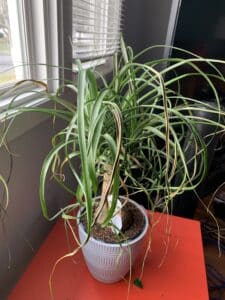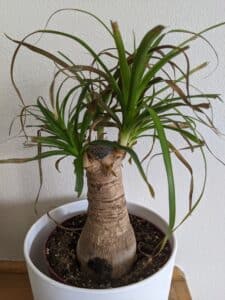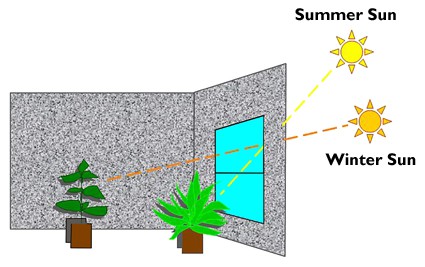Ponytail Palm, commonly known as elephant’s foot, is a long-lasting succulent that thrives in low-maintenance indoor environments.
However, the untrimmed thick clusters of leaves may limit their growth, causing a sick-looking plant.
Therefore, you should occasionally rid it of dead, decayed, and infected leaves to rejuvenate the plant.
Prune Ponytail Palm throughout the growing season by trimming pest-infested leaves, dead or decayed foliage, and top leaves to give it a signature palm tree-looking appearance.

Moreover, you can remove suckers from the plant base that could be propagated during the same growing season.
Read on to find out how to prune your Ponytail Palm without causing any severe damage.
Table of Contents
Should I Prune the Ponytail Palm?
Almost every houseplant needs occasional or seasonal pruning to stay healthy, good-looking, and thriving. Ponytail Palm is no different!
Although not a real Palm tree but an Asparagaceae species that include Hyacinth, Asparagus, and Spider plant, it benefits from occasional pruning throughout the growing season.
Ponytail Palm can be pruned any time of the year, but it is less likely to be damaged during the growing season (spring until fall) because it is still active.
Pruning removes dead and dying foliage, branches, and stubs, allowing room for new growth and protection from damage.

When pruning it, ensure to trim the top to force the foliage to grow downward, resembling a Palm tree.
Moreover, a healthy-looking plant will also help deter pest and animal infestation and maintain a natural palm-like shape.
How to Prune Ponytail Palm?
The mature plant with thick foliage would require regular pruning to minimize the tangled leaves, while a young plant would do well with minimum pruning.
However, pruning a Ponytail Palm is pretty simple and can be done in a few quick steps.
Place your Ponytail Palm at eye level to inspect the top leaves with ease.
Step #1: Inspect the Plant
- Start with inspecting for yellowed, brown, and decayed leaves.
- Next, inspect for pest infestation and eggs by checking the undersides of the leaves. A web-like substance may indicate spider mite infestation.
- Some disease-infested Ponytail Palm will exhibit yellowed leaves and caudex (plant’s base).

Step #2: Pruning the Leaves
- Start with trimming the yellowed and browning leaves, including decayed and dried leaves.
- Ensure to snip off the leaf with a diagonal cut to retain the sharp-end appearance.
- Make each cut at a 45-degree angle so that the water does not collect, promoting diseases.
- Next, trim the top of the leaf cluster by removing 2/3rd of the top growth, which encourages vigorous growth towards the sides.
- As the leaves grow longer, you can cut them short by giving them a signature Palm look.
- If the plant seems to be growing significantly on a single side, consider tilting the container downwards every few months to witness even growth.

Note: Do not remove excessive foliage because the new top will increase, requiring frequent pruning. Prune only 20% of its afflicted foliage at once.
Step #3: Remove Suckers
Suckers must go because they suck essential nutrients off the plant.
- Grab them with your thumb and index finger and carefully twist them to remove them.
- Otherwise, use a sharp pruning shear to cut the sucker close to the plant.
- Prepare them for propagation in a new pot or throw them away.
Maintenance and After-Care of Pruned Ponytail Palm
A succulent plant, Ponytail would not require frequent watering or repotting, and it manages well in a minimal growing environment.
Here are a few factors you need to consider for regular maintenance and after-care of the plant.
1. Adequate Sunlight and Proper Location
A succulent would dry up quickly when exposed to direct sunlight; hence, consider keeping your Ponytail Palm in a sunny location with sufficient indirect sunlight.
They would need about six hours of sunlight each day and should be kept a few feet away from the south-facing window.
Otherwise, keep under LED grow lights with appropriate wavelengths if your area lacks sunlight.

2. Ideal Temperature
Ponytail Palm grows well in average home conditions with room temperature and low to moderate humidity levels.
Provide a warm temperature of 60 to 80°F in the growing season and slightly more relaxed, 50-55°F in winter.
Keep them close to the window with indirect sunlight to promote the quick healing of freshly cut leaves.
3. Fast-draining Succulent Potting Mix
This is applicable if you repot your plant during or after pruning.
Choose fast-draining soil that contains a lot of organic materials and sandy soil. The cacti and succulent potting mix may be appropriate for Ponytail Palm.
If a succulent commercial mix is not your choice, make it at home using one part of regular potting soil, one part perlite or pumice, and coarse sand.

4. Occasional Watering
A freshly pruned Ponytail Palm would require slightly moist soil to help transfer nutrients to the pruned sections.
A succulent does not enjoy overwatering. After watering it once, let 2/3 of the soil dry out between watering.
Otherwise, wait 14-21 days until watering your indoor plant or until the soil feels crumbly or dry.
Similarly, cut back on watering in winter to prevent soggy soil at least once or twice throughout the winter.
Read our blog about when and how to water Ponytail Palm.
5. Monthly Fertilization
It will be a good idea to fertilize the plant after pruning, especially when done in the growing season, to boost new growth.
Fertilize your Ponytail Palm once or twice a month during spring and summer, but cut back if you have pruned the plant in early winter.
Apply a succulent-appropriate fertilizer such as Neptune’s Seaweed (0-0-1), containing macronutrients and amino acids.
Cut back on fertilization in fall and winter or whenever you witness brown leaf tips that indicate fertilizer-stressed plants.
6. Repotting Ponytail Palm
Consider repotting only when the plant roots have grown significantly, especially in early spring. However, they can go many years before requiring repotting to a larger pot.
When repotting, choose a container at least an inch larger than the current container.
7. Avoid Winter Stress
A recently pruned Ponytail Palm may easily suffer when exposed to cold drafts. Hence, bring your plant inside and cut back on everything except warm temperatures and lighting.
The dropping temperature and low-light conditions may quickly send the plant to shock, causing droopy and drying foliage.
Alternatively, use appropriate grow lights to compensate for the lack of sunlight.
Conclusion
Ponytail Palm does not have multiple branches, making them quite woody and bulky in appearance, but do not mistake it for an aging plant.
Pruning the woody base may leave an open trunk with no greenery. Moreover, it would expose the stem to mold and mildew.
Hence, keep the pruning to the foliage and provide appropriate after-care to witness a healthy plant.
Related Article: How to Propagate Ponytail Palm?


